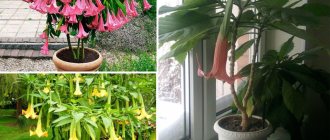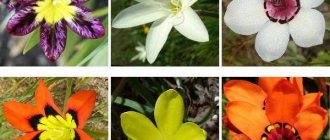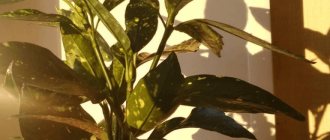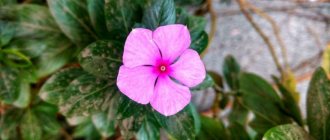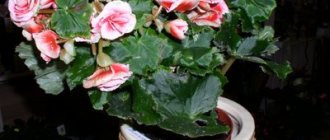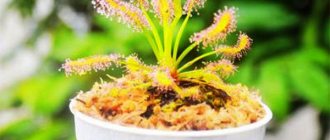Description of the plant
Wet vanilla is scientifically called balsam. More precisely, it is Sultan's balsam. But this name did not catch on among the people: it was too loud for such an unpretentious flower. Therefore, they began to call him in a simple way: Vanka, Ivan. And it began to be called wet because after abundant watering it seems to cry: droplets can be seen on its stems at this time: tears. But they are not salty, but sweet. Other names for this plant: sparkle (due to the bright color of the flowers) and impatiens (due to the shedding of seeds when touching the plant).
Sultan's balsam is a perennial herbaceous plant represented by four hundred species. Its homeland is the countries of Asia and Africa, where tropical and subtropical climates reign. But such a microclimate is easy to recreate at home.
Depending on the variety, under natural conditions, wet roly can reach a height of 0.2 to 2 m. The plant forms a thick, fleshy and juicy, but very fragile and highly branched stem. It is densely covered with dark green leaves sitting on short petioles. In places, sweet crystals form on the shoots: they form in extreme heat after heavy watering when the sweet juice secreted by the plant dries.
The flowering of the flame begins in early spring and ends in late autumn. With good lighting and care, these indoor flowers can form buds even in winter. Flowers can be regular or double. Their color can be one-tone or two-tone. The color of the petals can be different: usually it is bright and rich.
This is interesting! It is believed that wet vanilla gives men virility. Therefore, the flower should be placed in the matrimonial bedroom. However, balsam does not like abuse. Therefore, he stops “acting” if there is frequent fighting in the house. According to other sources, the light brings trouble to the family by causing drunkenness in the head of the family.
Garden balsam
Unpretentious balsam - Vanka wet - is also used in decorative and home gardening. At the same time, plants of familiar indoor varieties are often used for landscaping and landscape design, planted in containers or open ground.
Along with the houseplant Vanka wet, an annual form called “garden balsam” is also used in landscape design. This plant spread from Eastern India, where it occurs wild. It has a lush, erect bush with succulent, fleshy shoots and green, jagged leaves.
The plant blooms long and profusely. The flowers of Vanka wet can be simple or double. They are distinguished by a wide palette of different shades. This heat-loving plant requires a well-lit place. Garden balsam is propagated by seeds.
Often, signs and superstitions are associated with the indoor flower Vanka wet. They say that it has a positive effect on creative people and helps create an atmosphere of harmony and harmony in the home. If peace and respect reign in the family, this flower will bloom magnificently and for a long time. Misunderstandings and disagreements between family members, on the contrary, can have a negative impact on the plant.
Vanka wet received its name because of this feature: droplets of juice often appear on its juicy green stems. Probably for the same reason, a superstition arose that because of the flower, family members may develop a penchant for alcohol.
How these facts are related to each other is unclear. And, of course, it’s up to everyone to believe in such signs or ignore them. But in favorable conditions and a sincere home atmosphere, balsam will bloom and become prettier day by day, delighting household members with the bright lights of its flowers.
Video about a wonderful plant
It’s interesting that back in the 15th century people thought of keeping plants indoors. True, this happened all the way in Egypt. In China, special rooms were allocated for plants (now called greenhouses). In our country, this bright idea came to the people’s minds only in the 19th century.
Vanka wet red
There are often some superstitions and omens associated with house plants. For example, it is believed that there are flowers that cannot be kept at home, but only in the office. There are plants that “love” men, while others love women. Many housewives dream of a cozy home and decorate it with flowers. And if it turns out that female flowers predominate over men, then an energy imbalance occurs, and such circumstances arise that men begin to leave this house.
The opposite can also happen. There are vampire flowers that should be avoided in the house in order to maintain harmony and harmony, as well as the health of the household.
When you come to visit someone, plants immediately attract attention. If you see that indoor flowers are beautiful and well-groomed, and are blooming vigorously, then the energy of this house is good, but if the flowers are yellow and sluggish, then you can conclude that something bad is happening in this family. A plant called Vanka Wet Flower or Ogonyok, as it is also called, is particularly beautiful and mysterious
He came to us from Africa or from America - it is in these countries that the flower lives
A plant called Vanka Wet Flower or Ogonyok, as it is also called, is particularly beautiful and mysterious. He came to us from Africa or from America - it is in these countries that the flower lives.
The first time it was presented was to Queen Elizabeth of England (16th century), who was amazed when she saw frozen tears of sugar (crystallized juice) on its stems.
The plant came to Russia much later, only in the 19th century. I immediately liked the flower because it is not capricious and beautiful. They called him Vanka the Wet. The height of the flower ranges from 40 to 70 cm. Vanka's stems break very easily, so it must be transported very carefully.
Types and varieties
Here is a description of the most beautiful varieties of indoor balsam with photos:
- New Guinea . This type of wet willow is distinguished by dense foliage, colored in a rich dark green color and covered with a light gloss. It contrasts against the background with bright dark orange flowers, which have a small “spur” at the bottom.
- Paradise . The leaves of this variety are very dark, without gloss. Against their background, simple scarlet flowers look impressive.
- Java . The leaves of this balsam are green with a bronze tint. The flowers are painted in various shades of pink.
During flowering, wet Rolyflower really looks like a light. Regardless of the variety of balsam, the flowers of this plant are as bright as flames.
An ideal flower for beginner gardeners Vanka wet
Touch-me-not, evergreen, light, Vanka wet flower - all these are names for one plant, which is quite often found in our apartments.
The homeland of this pretty flower is tropical Asia and Africa. It is one of the most unpretentious and easy plants to grow at home. Ogonek takes root easily, grows quickly and looks very impressive during flowering: its compact bushes, strewn with bright flowers, can decorate any room. The Vanka wet flower also has another name - balsam. With good care, it can bloom almost all year round, and providing it with favorable conditions is not difficult.
Even a novice gardener can easily cope with growing this plant. It is perennial, but due to its rapid growth, the shoots usually become elongated, the bush becomes spreading and quite soon loses its compact shape. Therefore, balsam lovers often take cuttings from old plants in the spring, growing new bushes.
Impatiens bloom better if planted in a slightly cramped pot or container. A plant in a pot that is too spacious will not bloom lushly.
Selection of location and conditions of detention
Now let’s find out in what conditions impatiens need to be kept so that the plant forms a bush densely covered with bright flowers.
Lighting and location
Vanka wet loves a lot of light, but it must be diffused. Therefore, it is best to place the pot on an eastern or southern windowsill with light shade. You can place the plant at the back of the room if it is well lit. In summer, the flower can be placed on the balcony, but in cold and windy weather it must be brought home. In winter, you can illuminate the balsam with an artificial lamp, but this is not urgently necessary.
Temperature
The optimal temperature for growing Sultan's balsam is +18...+20 oC. The plant is not afraid of short-term heat (about +30 °C), but does not tolerate cold (below +15 °C).
Air and humidity
The flame requires well-humidified air (60-80%). Its leaves should be frequently sprayed with lukewarm water. Do not leave a pot with a flower in a draft.
Soil and pot
The soil for wet roly-poly should be loose and light. It is desirable that it has a slightly acidic reaction. It should not contain many nutrients, since excess organic matter leads to an increase in the green part of the plant and a decrease in the number of buds.
You can buy universal soil for indoor plants. But it is better to use a mixture of river sand, peat and leaf soil. These components must be taken in a ratio of 1:1:2.
A pot for wet roly-poly should be of medium size. Its diameter and width should be 15-20 cm. Indoor balsam grows quickly, so there is no point in planting a small bush in a small pot first: after a month it will have to be transferred to another container.
It is better to choose plastic as a material, as it retains water better. If the pot is ceramic or clay, then you will have to water the flower more often. It is important that the pot has drainage holes.
How to care for indoor impatiens flower
Location. Once upon a time, balsam could be found in almost every apartment. Adults loved it for its beauty during flowering and ease of care, and children feasted on the petals of pink and white flowers with a pleasant, sour taste.
It is not difficult to provide decent conditions for growing balsam, because it is truly a very unpretentious plant. It feels great not only in the room, but also outdoors. Therefore, in summer you can easily transport it to the garden plot or take it out to the balcony.
Impatiens grow well on any, even northern windows; they only need shading from direct, hot sunlight on southern windows. At high temperatures and lack of light, plants shed their leaves.
After gradual hardening, the light-loving Sultan's balsam can be placed in open places, and the shade-tolerant Waller's balsam can be placed in places protected from the sun. The plant should be removed from open ground long before the night frosts.
The soil. It is better to plant them in pots commensurate with the root system, filled with a loose nutritious soil mixture of leaf soil, greenhouse soil and sand (4: 2: 1).
Impatiens like to grow in small containers, so when replanting them in the spring, choose a flower pot that is only slightly larger in size than the balsam's root system.
Feeding. When caring for balsam flowers at home, fertilizing with complete mineral fertilizer should be done at least twice a month. In summer, they should be watered abundantly and fed every 10–15 days with mullein (1:10) or a 2% solution of complete mineral fertilizer.
Watering. During the growing season, growing and caring for balsam requires regular watering, especially during dry periods. In winter, keep at a temperature of 14–16 °C, water less often, without flooding, since balsams do not stop growing during this period.
How to care for indoor balsam flowers, which are New Guinea hybrids? They should definitely be pinched. Frequent loosening of the soil and weeding are necessary.
If your plant drops yellowed lower leaves and does not bloom, it means it is not getting enough light. Move it to a brighter place.
If a plant's leaves fall off in winter, it means your plant is cold—put it in a warmer place.
If the root collar of the plant becomes covered with black spots, pay attention to watering. You're probably over-watering the soil
Stop watering the plant until the soil dries out.
The main pests when growing balsam flowers are aphids, spider mites, feltworms and nematodes.
Care
Caring for a wet roly-poly is quite simple. Therefore, this flower is suitable for beginners in the field of floriculture.
Watering
The wet plant needs to be watered with lukewarm, settled water every time the top layer of soil begins to dry out. The soil should not be allowed to dry out completely: otherwise the stems will quickly shed their leaves, they will become bare and ugly. At the same time, the number of buds formed will sharply decrease.
You need to water abundantly: some of the excess water should come out through the drainage holes. In summer, during extreme heat, it is better to moisten the soil once a day or two. In winter, watering can be reduced to once a week. During the period of active growth, it is advisable to give the plant a shower 3-4 times a month: to do this, spray it with lukewarm water from a spray bottle. It is better not to do this procedure in winter.
Top dressing
Since wet willow blooms from spring to late autumn, it needs to be fed only with complex fertilizers for flowering plants. Fertilizers from the following brands are suitable for this: Agricola, Zdraven, Kemira. Uniflor-Bud fertilizer is well suited for this.
Fertilizing is combined with watering and done once every 2 weeks until the plant finishes blooming. But it is better to use a less concentrated solution (take 2 times less fertilizer than indicated on the package), since excess minerals will reduce the number of buds that form.
Loosening, mulching
When a hard crust forms, the soil in the pot must be carefully loosened. This can be done using a toothpick: stick it into the ground strictly vertically so as not to damage the balsam roots.
Pinching, pinching, pruning
There is no need to trim indoor flowers. But if you want to get a more lush bush, then you can pinch out the growing point of the side shoots. Then new branches will grow on them. This also stimulates the formation of new buds. But this makes the leaves become smaller and less beautiful.
Transfer
Wet Vanya should be replanted every spring. Moreover, it is not necessary to use a new pot: you can use an old one. Only it will need to be treated with potassium permanganate. But the soil must be fresh. A new container will only be needed if the flower initially grew in a very small (less than 10-15 cm in diameter) pot.
How to care for balsam at home
Indoor impatiens flower: care at home, pruning, photo of flowers.
Watering
In the spring-summer period, water the plant regularly and abundantly as the surface layer of the earth dries to a depth of 1 cm.
Despite the fact that impatiens have a need for a large amount of moisture, its excess can lead to rotting of the root system of the flower and its death, especially at low temperatures and insufficient light.
It is necessary to water the balsam with soft warm water: rain, snow or well-settled (at least 24 hours) tap water.
From time to time after the irrigation procedure, it is useful to loosen the soil to increase the access of oxygen to the roots of the plant.
It is advisable to pour water along the edge of the pot to prevent it from getting on the root collar. Excess liquid from the pan should be removed.
Air humidity
Balsam is quite undemanding to air humidity.
However, increasing the room temperature above 22ºC can negatively affect the formation of the plant and lead to diseases (find out about balsam diseases and their treatment in this material).
To avoid adverse consequences, periodically spray the impatiens with water from a spray bottle, avoiding its contact with the opened buds, otherwise the decorative qualities of the plant may suffer.
In spring and summer, balsam often turns yellow due to dust on the leaves, which leads to a lack of light for the production of chlorophyll. In this case, it is necessary to regularly arrange hydro-procedures for the plant - washing the leaves under running water at room temperature.
Temperature
The optimal temperature regime for cultivating balsam is from 16 to 25 ºС.
When growing a flower, you should periodically ventilate the room, and also avoid drafts and hypothermia.
Lighting
Considering that balsam is a light-loving representative of the flora, it is placed in well-lit areas of the living space, but without access to direct sunlight. Therefore, the ideal place for cultivating the plant would be windows on the east and west sides.
If impatiens are grown on south-facing window sills, then they need to be shaded from 12 to 17 hours local time.
Top dressing
When choosing nutrient mixtures, preference is given to complete complex fertilizers, in particular phosphorus-potassium fertilizers intended for indoor flowering plants.
They are applied according to the instructions in half the dose once every two weeks from April to October.
It is recommended to use fertilizers with a low nitrogen content, since the latter causes an increase in green mass.
It also leads to a reduction in the size and number of flowers.
Trimming
With the onset of spring, the plant requires pruning, during which the annual growth is shortened by half.
In addition, the plant can be shaped throughout its entire growing season: when young shoots reach a given length, the upper growth point is pinched, which stimulates the formation of new side stems, which are the main suppliers of bright, beautiful buds.
During the year, overgrown and weakened shoots are removed, and diseased and discolored parts of the plant are cut off.
Impatiens growth rate
Impatiens manifests itself as a fast-growing plant if, in caring for it, you strictly adhere to the agricultural techniques of growing the flower: observe the temperature and humidity conditions, replant annually in larger containers, water in a timely manner, apply fertilizers, etc.
The determining role in the growth rate of a pet is played by its appearance. Recently, breeders have developed dwarf forms of the plant up to 15 cm high, as well as low-growing hanging varieties that grow horizontally up to 40–60 cm.
Traditional flower forms, for example Waller's balsam, reach 60–80 cm in height and already 90–100 days after emergence they delight the eye with their friendly flowering.
Lifespan
The balsam family includes both perennial plants and annuals, the life cycle of which occurs within one year.
Many florists prefer to grow even recognized centenarians of the genus Impatiens in annual culture, planting them in separate pots and placing them on flower beds, balconies, open terraces or rooftops. If it is intended to cultivate impatiens as a perennial, then it is pruned every spring.
One of the equally important procedures for care and cultivation is propagation and planting (transplantation), about which our specialists have prepared interesting materials.
Reproduction
Sultan's balsam is propagated by stem cuttings. For this:
- Cut off the top of a healthy shoot 5-6 cm long.
- Place it in a glass of water.
- Change the water every day.
- When roots 2-3 cm long appear (usually after 2 weeks), plant the cuttings in a pot.
Another way to root cuttings is to plant them directly in a pot with soil. But you need to make sure that the substrate never remains dry.
Advice! While rooting the balsam stem cutting, place the pot in a shaded area.
Balsams are rarely propagated by seeds. Typically, this method of propagation is resorted to when there is nowhere to get a stem cutting from.
Planting wet vanilla seeds for seedlings:
- Prepare a bowl by pouring the substrate into it that is used for growing adult plants.
- Moisten the soil and scatter balsam seeds over its surface.
- Lightly press down the seeds with your hands, but do not bury them.
- Cover the blanket with polyethylene and place it in a well-lit and warm place.
- Ventilate the bowl daily by removing the film from it. If necessary, moisten the substrate by spraying.
- After the first shoots appear, remove the film.
- When the seedlings reach a height of 1 cm, transplant them into seedling cups.
When the seedlings form powerful bushes, pinch their tops and transplant them into permanent pots.
Diseases and pests
Diseases rarely affect impatiens. A flower can only get sick if it is not cared for properly. This usually happens in winter, when it is cool on the windowsill and cold air blows through the cracks in the window. At this time, with excessive watering, the soil turns sour and the roots begin to rot. In this case, the flower must be urgently transplanted into a new pot with a new substrate.
Other problems you may encounter when growing moss at home, and how to solve them:
- Leaves fall . The flower is either too hot or too cold. This can also happen with infrequent watering. You will have to adjust the maintenance conditions and restore the watering schedule.
- There are very few buds . This happens if balsam is kept in poor lighting conditions. Another reason is the excess amount of minerals and organic matter in the soil. In this case, the plant forms a powerful bush, and it looks completely healthy.
- Leaves become pale . They sag, and there is a thin cobweb in the internodes. This happens when a plant is damaged by spider mites. Typically, this pest lives in conditions of low air humidity. To combat it, use insecticides (Aktaru, Inta-vir, Karbofos).
- Leaves and stems are deformed . And on their surface clusters of pests are visible. This is an aphid. It can be destroyed manually. Spraying the plant with soapy water also helps against it.
Vanka wet is a fast-growing and almost continuously flowering indoor plant. It requires good but simple care. That is why the flower is so common among beginners and amateurs. Plant it on your windowsill to admire the fiery flowers against the dark and shiny foliage.
